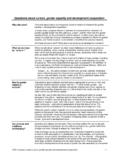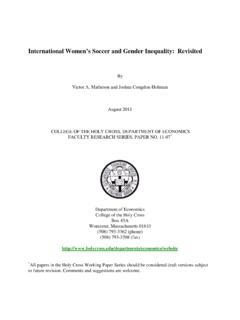Transcription of GENDER EQUALITY AND - kics.sport.vlaanderen
1 GENDER EQUALITY AND. LEADERSHIP IN SPORT1. Despite the gradually increasing rates of women's participation in sport , there is still a strikingly GENDER - unbalanced representation in decision-making positions in sports organisations. Recent statistics2 show that there are very few women in leadership positions in the Olympic and Paralympic Committees, in European and national sport governing bodies, and in national sport federations. This underrepresentation of women in leadership positions in sport can be explained by prevailing masculinised sport settings, stereotypical GENDER roles, but also by GENDER - blind or biased institutional norms and procedures. Many executive members are elected by their peers, who often tend to elect new leaders that feature similar characteristics as themselves. In order to ensure a more balanced representation of women and men in leadership positions in sport , several institutions are issuing policy recommendations, establishing targets, or implementing initiatives.
2 A number of examples are described below. Since 2015, the Council of Europe3 is inviting the governments of the Member States to develop policies and programmes to achieve a GENDER -balanced representation in public authorities and public bodies related to sport. The Member States are also encouraged to integrate a GENDER perspective in all areas of decision- making. A similar recommendation was made by the Council of the European Union in 20144. The European Commission's Proposal for Strategic Actions in GENDER EQUALITY in sport (2014-2020)5 recommends to achieve the following targets by 2020: A minimum of 40% of women and men in executive boards and committees of national sport governing bodies and 30% in international sports organisations located in Europe. A minimum of 40% of women and men in the management of professional sport administrations and governmental bodies. The Olympic and Paralympic International Committees are engaged in raising the number of women in leadership positions.
3 Both international committees established targets (20% and 30%, respectively) to increase the number of decision-making positions for women (particularly in executive bodies) in the 1. This factsheet was compiled in October 2016 by Yellow Window. 2. For more detailed information about recent statistical data see, for example, the 2016 Women on Boards Report on GENDER Balance in Global Sport, or the 2015 European Institution for GENDER EQUALITY Report on GENDER EQUALITY in Power and Decision-Making. 3. Council of Europe (2015). Recommendations on GENDER mainstreaming in sport (CM/Rec (2015)2). 4. Council of the European Union (2014). Conclusions of GENDER EQUALITY in sport . 5. European Commission (2014). GENDER EQUALITY in sport . Proposal for Strategic Actions 2014-2020. Olympic and Paralympic Movements. Both international committees are undertaking complementary initiatives to support the achievement of these targets. EXAMPLE 1. WoMentoring project Promoter: International Paralympic Committee and Agitos Foundation Implementation period: 2014-2016.
4 WoMentoring was created to help contribute towards the Paralympic Movement's target of having 30 %. women in leadership positions. This project had a duration of 18 months and involved 16 pairs of mentors and mentees in a programme of education and development. WoMentoring provided its participants with tools to grow into strong leaders. Several mentees recognised that the guidance from their mentors and support was crucial to gain confidence and skills to achieve their goals. The positive impact of the approach is clear as the mentees managed to be promoted and to gain various positions of influence within National Paralympic Committees and para-sport organisations. Eleven sport federations in continental Europe6 decided to implement GENDER quotas to contribute to a balanced representation of women and men for their highest decision-making bodies ( executive committee, presidium and board of directors) and/or for councils, committees and commissions. Although Women in sport ' commissions or committees are becoming popular in sports organisations, they are still rather scarce.
5 These structures can be found in the international and national Olympic and Paralympic Committees, as well as in five sport federations in continental Europe. Within their mandate, they propose policies to increase female participation in sport at all levels, including in leadership positions. Governmental bodies responsible for the policy area of sport also have a role in promoting measures to increase the number of women in leadership positions in sport . EXAMPLE 2. Understanding the state-of-play of GENDER EQUALITY in sport in Finland Promoter: Finnish Ministry of Education and Culture Implementation period: 2011-2012. The Finnish Ministry of Education and Culture published in 2012 a report describing the state-of-play of GENDER EQUALITY in sport in the country. This report also included a set of recommendations in relation to planning, managing and leading future developments towards a more GENDER -sensitive sport policy-making. The analysis undertaken looked into different dimensions, including the representation of women and men in decision- making and leadership positions in sport .
6 This report was a follow-up of a similar exercise undertaken in 2005. How to integrate a GENDER perspective in sport decision-making processes? - Implement transparent and fair procedures to identify and elect candidates that do not benefit either of the sexes and recognise different achievements and experiences to perform a certain role. - Publicly advertise job offers for professional management positions in sport . - Ensure a GENDER -balanced representation of nomination and selection committees. - Create GENDER -sensitive human resources policies that allow for the reconciliation of work and private life ( that allow combining family responsibilities and decision-making roles). - Change internal regulations and statutes in order to promote GENDER balance as a principle of good governance. - Develop (or fund) programmes and projects to raise awareness about the benefits of GENDER diversity in leadership positions, and to develop leadership skills of the underrepresented sex.
7 6. United World Wrestling Europe, European Fencing Confederation, European Handball Federation, European Shooting Confederation, European Weightlifting Federation, Union of European Football Associations, European Hockey Federation, FIBA Europe, European Triathlon Union, European Table Tennis Union, and the European Taekwondo Union. Source: European Institute for GENDER EQUALITY (2015). GENDER EQUALITY in Power and Decision- Making Review of the Implementation of the Beijing Platform for Action in the EU Member States.











